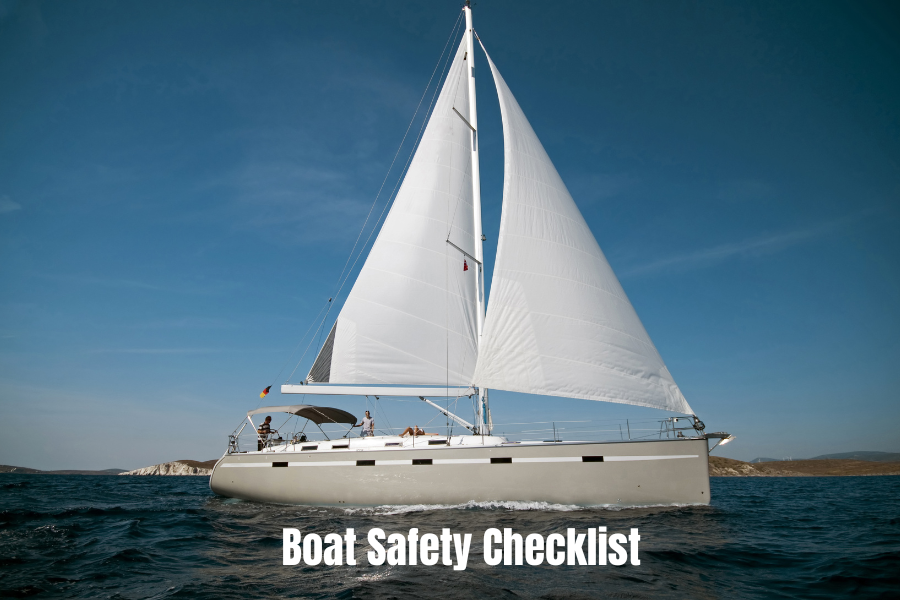Safety checklist for boat: Setting sail or cruising on your new yacht is an exhilarating adventure! To ensure smooth sailing and peace of mind, let’s dive into this comprehensive safety checklist tailored for you. Remember, safety isn’t just a box to tick; it’s a mindset that ensures you enjoy every moment on the water. If safety is very important to you, consider purchasing my Boat Safety Checklist guide.
An excellent place to purchase boat safety equipment is Wholesale Marine.

Safety Checklist For Boat
Before You Cast Off – Boating Safety Equipment Checklist
- Life Jackets (PFDs): It’s not just about having enough; it’s about the right fit for everyone on board. Make sure they’re U.S. Coast Guard-approved, in good condition, and readily accessible. Children should have life jackets designed for their weight and size. A good safety checklist for boat will always have life jackets listed first!
- Visual Distress Signals (VDS): Flares, signal mirrors, and SOS lights – these are your lifelines in emergencies. Check expiration dates, learn how to use them, and store them in a waterproof, easily accessible location. Checkout the signaling devices on Wholesale Marine here.
- Sound Signaling Devices: A whistle, horn, or air horn can alert others to your presence, especially in low visibility. Test them regularly and keep them handy.
- Fire Extinguishers: Ensure you have enough fire extinguishers for the size of your boat, and they’re U.S. Coast Guard-approved. Check pressure gauges, expiration dates, and know how to use them. Don’t forget to show your crew where they are and how to operate them.
- Navigation Lights: These lights aren’t just for show; they signal your presence, direction, and type of vessel to others. Check that all lights are working correctly and that you have spare bulbs.
- First Aid Kit: Stock it with essential supplies like bandages, antiseptic, pain relievers, and seasickness medication. Consider taking a first aid course to brush up on your skills.
- Radio Communication: A VHF radio marine is your lifeline to call for help and monitor weather forecasts. Familiarize yourself with its operation, know the emergency channels, and consider a handheld radio as a backup.
- Tools and Spare Parts: A basic toolkit with wrenches, screwdrivers, pliers, and spare parts like fuses, bulbs, and belts can save the day when unexpected repairs are needed.
- Weather Forecast: Always check the weather forecast before heading out. Be prepared for changing conditions and have a plan B if the weather turns sour.
During Your Voyage – Safety Checklist for Boat
- Life Jacket Drill: Conduct a life jacket drill with your crew, ensuring everyone knows how to put on their PFDs quickly and properly.
- Man Overboard (MOB) Procedure: Discuss and practice your MOB procedure. Designate roles and responsibilities, and know how to use your boat’s equipment to retrieve someone from the water.
- Fire Drill: Familiarize yourself with the location of fire extinguishers and how to use them. Conduct a fire drill so everyone knows what to do in case of a fire.
- Watchkeeping: Maintain a proper watch, especially at night and in busy waterways. Keep a lookout for other vessels, hazards, and changes in weather.
- Alcohol and Drugs: Excessive alcohol consumption and drug use impair judgment and reaction time. Be responsible and designate a sober skipper. A safety checklist for boat needs to consider things other than equipment.
Boating Season Follow These Tips – Dafety Checklist for Boat
- Float Plan: Leave a float plan with a trusted friend or family member. It should include your itinerary, crew list, and emergency contact information.
- Emergency Equipment: Consider additional safety equipment like an EPIRB (Emergency Position Indicating Radio Beacon), PLB (Personal Locator Beacon), or satellite phone for remote areas.
- Training: Take boating safety courses and learn basic navigation and seamanship skills.
Fair Winds and Following Seas!
By taking these safety precautions seriously, you’re setting yourself up for a fantastic cruising experience. Remember, a well-prepared cruiser is a confident cruiser! Also, remember that good spring prep increases safety! So hoist the sails, fire up the engines, and let the adventure begin!
Get Our Boat Safety Checklist Guide
Get more than just a safety checklist for boat; download your copy of the Boat Safety Checklist guide now!